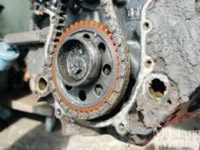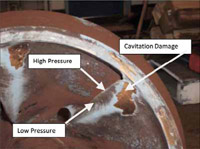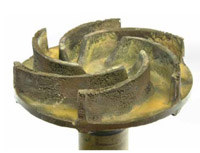Houston Dynamic Service Completes a CENTRI-STAK Compressor Repair Project
July 21, 2013It’s That Time of Year Again! 42’nd Annual Pump/Turbo Symposium
September 9, 2013Vital Items to Check on a Centrifugal Pump After Disassembly
After taking delivery of a pump in our shop for repair, our general protocol is to disassemble the pump, and then carefully inspect for primary types of wear and tear. This is done prior to the pump being blasted and run through NDT (Non-Destructive Testing) in order to identify potential issues that could be causing inefficient pump operation. When these items are identified and addressed, we can often avoid having to go through the more intensive process of blasting and NDT.
Corrosion
 Is there any notable corrosion to the impeller? Because the impeller is the moving element in a centrifugal pump that drives the fluid, it will wear down over time. Any corrosion to this part will mean the impeller will grab less, and therefore will push less liquid through the pump.
Is there any notable corrosion to the impeller? Because the impeller is the moving element in a centrifugal pump that drives the fluid, it will wear down over time. Any corrosion to this part will mean the impeller will grab less, and therefore will push less liquid through the pump.
Evidence of Rubbing
 One sign of rubbing is the presence of metal shavings. This can be hard to detect by the untrained eye – especially if the pump is used in an abrasive application. Signs of rubbing can often be found within the pump casse and bearing housing. If you see signs of rubbing, this could mean excessive bearing wear or impellar imbalance, among other things.
One sign of rubbing is the presence of metal shavings. This can be hard to detect by the untrained eye – especially if the pump is used in an abrasive application. Signs of rubbing can often be found within the pump casse and bearing housing. If you see signs of rubbing, this could mean excessive bearing wear or impellar imbalance, among other things.
Cavitation
 Cavitation is the formation and then immediate implosion of cavities in a liquid – i.e. small liquid-free zones (“bubbles”) – that are the consequence of forces acting upon the liquid (source Wikipedia). Significant cavitation will result in an inefficiently operating pump. In order to maximize production, the cavitation must be repaired.
Cavitation is the formation and then immediate implosion of cavities in a liquid – i.e. small liquid-free zones (“bubbles”) – that are the consequence of forces acting upon the liquid (source Wikipedia). Significant cavitation will result in an inefficiently operating pump. In order to maximize production, the cavitation must be repaired.
Erosion
 Erosion is generally caused by particles that are present in the liquid running through the pump. Most internal parts fall prey to erosion, especially the pump housing, valute, and impellar. Again, the presence of erosion in pump parts leads to an inefficient pump, which effects production and consequently, profitability.
Erosion is generally caused by particles that are present in the liquid running through the pump. Most internal parts fall prey to erosion, especially the pump housing, valute, and impellar. Again, the presence of erosion in pump parts leads to an inefficient pump, which effects production and consequently, profitability.

